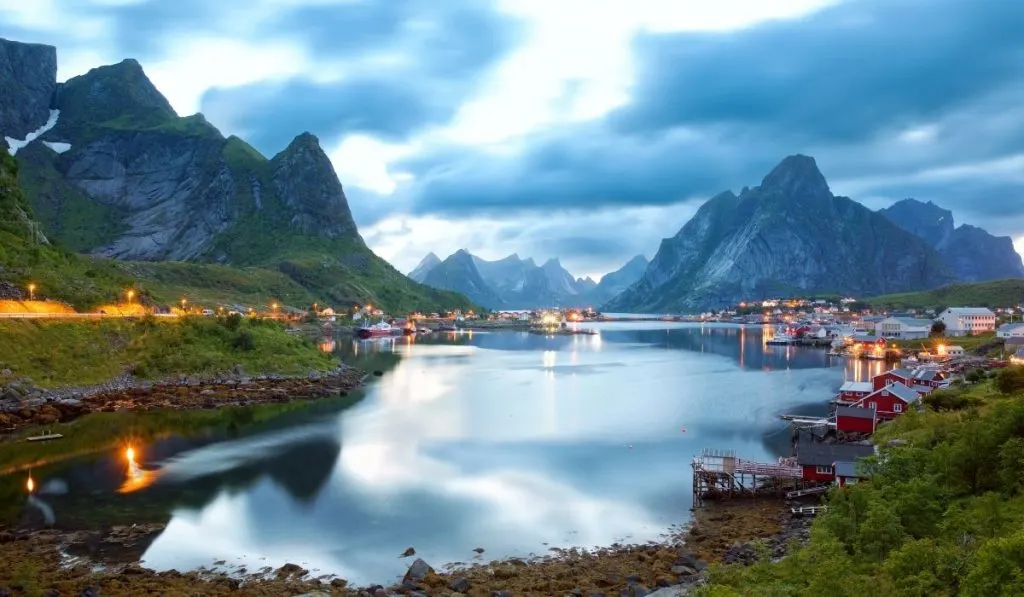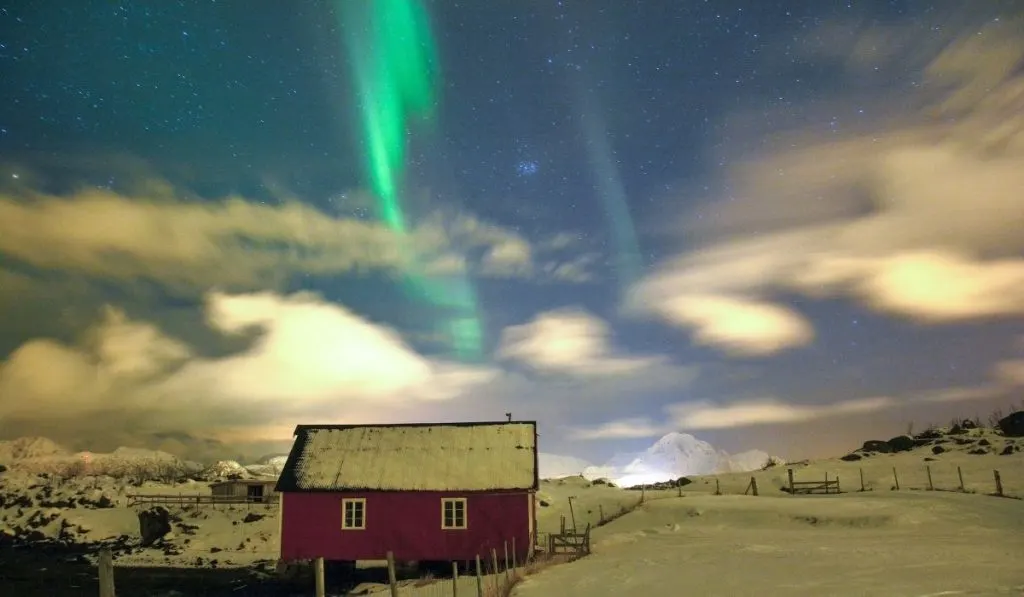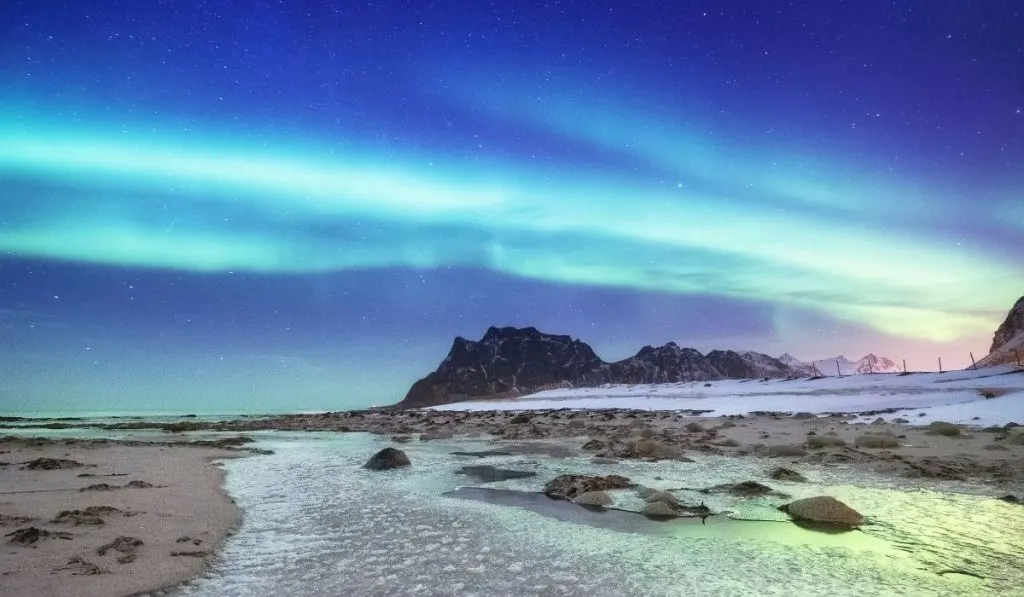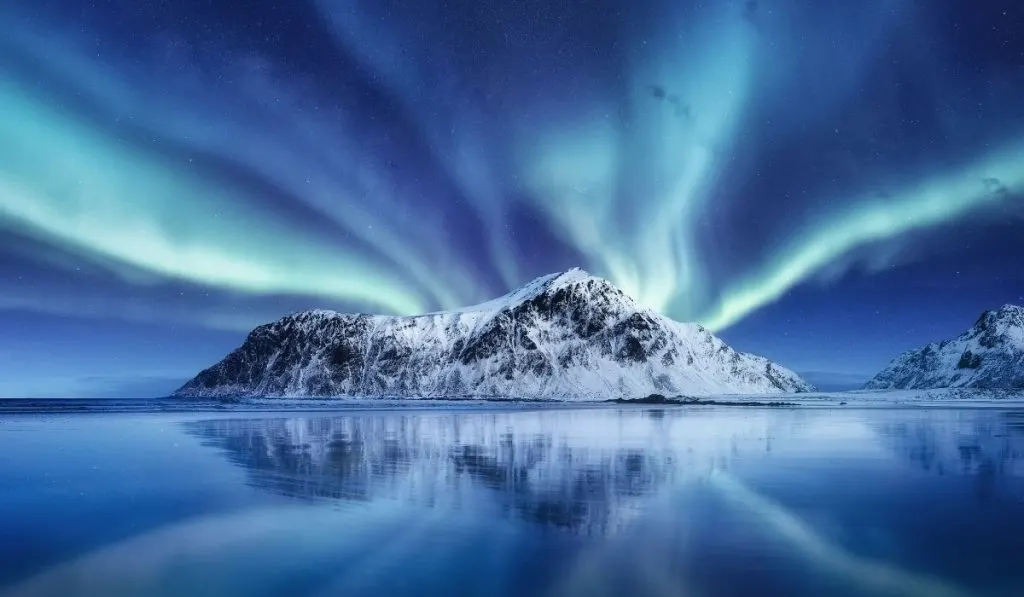The Northern Lights are generally present throughout the year. However, you may have heard that they are usually not visible during the summer months. Knowing this, you may be wondering when you should visit the Lofoten Islands to see the Aurora Borealis.
When is the best time to visit Lofoten Islands for Northern Lights?
In general, the best time to visit the Lofoten Islands for the Northern Lights is the non-summer months. The aurora zone sees almost 24 hours of daylight in the summer months. So, during that period, the chances of seeing the lights are low.
Beyond seeing the Aurora Borealis, you might have other reasons to visit the Lofoten Islands. So, in this guide, we review what you can expect in the Lofoten Islands at different times of the year. When done reading, choosing the best time to visit Lofoten Islands for Northern Lights should be much easier for you.
Month-to-Month Guide
The Northern Lights will always be in the skies of the Lofoten Islands. Sadly, they are not visible year-round. The intensity of the light varies with the length of daylight in the aurora zone.
Since summertime has the longest periods of sunlight on the islands, you are unlikely to see the Northern Lights during that period.
There are other times when the Lofoten Islands experience longer daylight. But even during those times, you stand more of a chance of seeing the Aurora Borealis than in the summertime.
Below, we give an overview of the visibility of the Northern Lights through the months in the Lofoten Islands.
January to March
January is a perfect time to visit Lofoten Islands for Northern Lights. The days are relatively shorter, so you have a very high chance of seeing the Northern Lights.
However, January on the Lofoten Islands is pretty cold. The temperature ranges from around 23 to 28 degrees Fahrenheit. Also, January sees one of the highest amounts of rainfall in the Lofoten Islands.
February is also a great time to visit the Lofoten Islands to see the Northern Lights. While the days are a bit longer than January, the difference is not too much to keep you from seeing the Aurora Borealis.
Besides having longer days than January, February comes with lower rainfall. So, the rain is less likely to keep you indoors.

February on Lofoten Islands is about as cold as January. The temperature ranges from around 21 to 30 degrees Fahrenheit.
In March, particularly early to mid-March, you can still see the Northern Lights on the Lofoten Islands. The volume of rainfall is also lower than in February. So, you are unlikely to get stuck indoors. Daylight in March is longer than in February, so you also get more sunny days.
From the end of March, the days become even longer. So, your chances of seeing the Northern Light drop significantly. By this time, the Lofoten Islands are on their way to the summertime of endless daylight.
January to March is the best time to get pictures of the Northern Lights with snowy mountains. So, if you fancy this idea, you may want to plan your trip during this period.
April to August
From early April to late August, you have almost no chance of seeing the Northern Lights with just your eyes.
During this period, the aurora zone gets daylight for roughly 24 hours. So, the skies are just too bright for the human eye to see the Northern Lights.
Between April and August, your best chance at seeing the Aurora Borealis is with a scientific tool. But then, the weather is milder during this period. The average temperature falls between 32 and 60 degrees Fahrenheit, and there’s minimal rainfall.
So, if you are open to seeing the Lofoten Islands without seeing the Northern Lights, April to August is a perfect time.
September and October
From the end of August to September, the visibility of the Northern Lights returns. But the nights are still short, so the lights are not as intense.
If you would like to go hiking with a chance of seeing the Northern Lights, September is an ideal month to visit the Lofoten Islands.
In October, the visibility of the Aurora Borealis drastically improves. In fact, alongside early March, October has the strongest activity of the Northern Lights.
While the Northern Lights are visible in October, the month comes with the highest volume of rainfall of the year. So, you may not be able to enjoy many outdoor activities.
October on the Lofoten Islands is also somewhat cold. The temperature ranges from 37 to 41 degrees Fahrenheit.
November and December
The Aurora Borealis will still be visible in November and December. Unfortunately, these months come with a lot of rain and storms. Also, the Lofoten Islands are pretty cold in November and December. So, in general, they are not really the best time to visit the Lofoten Islands.
November is particularly a non-ideal month to visit the Lofoten Islands. The month sees extended periods of wind, ice, rain, and darkness. So, it is relatively difficult to enjoy any outdoor activities or sights.
From early December to early January, the sun barely rises. So, if you want to see the Polar Nights, you may visit between December 9 and January 4.

Some of the Best Places to See the Northern Lights in Lofoten
You can get a superb view of the Aurora Borealis on the Northwest coast of Lofoten. Some of the places you should go include:
- Uttakleiv Beach – Uttakleiv Beach is a perfect spot for taking pictures of the Aurora Borealis. The foreground and mountain range serve as a picture-perfect backdrop for the beautifully lit sky. There might be some light pollution on the right side of Uttakleiv, but it won’t ruin your photo.
- Haukland Beach – this beach is also a lovely spot for taking beautiful pictures of the Northern Lights.
- Skagsanden Beach – thanks to its north-facing orientation, the Skagsanden beach is another perfect spot for taking photos of the Northern Lights. It comes with mountains in the background. So, when you are not taking photographs of the Aurora, you can use the background mountains as a backdrop for other pictures.
- Myrland Beach and Storsandnes Beach – these two beaches are super cozy, and they have large open waters. Thankfully, the waters do not cover the Aurora. So, you can get a good view while you are there. The only thing is they are away from the main road.
- Vik Beach – taking photos at Vik Beach is pretty exciting. There are many beautiful mountain views around. So, when you are not taking pictures of the Aurora, there are other exciting sceneries to focus on.

How to Increase Your Chances of Seeing the Northern Lights
- One of the many ways to increase your chances of seeing the Aurora Borealis is to look toward darker skies. Your best bet is to go to a spot with little light around – away from the big cities. Although, when the KP index is high, you just might get enough visibility in the small towns.
- The weather forecast can help you choose the perfect time to see the Aurora Borealis. When the clouds are thick, you wouldn’t see much. But when there’s variable cloudiness, you will enjoy the view. So, pay attention to the weather forecast for the days when the cloud cover will not be thick.
- Check darksky.net for a map of light pollution around you. With that map, you can go towards the dark where the Northern Lights are more visible.
- Do not try to see the Aurora Borealis during a full moon. The moonlight may affect the visibility and prevent you from getting your perfect picture.

Other Fun Activities to Do on the Lofoten Islands
The Aurora Borealis isn’t the only attraction of the Lofoten Islands.
- You can go cycling around various beautiful spots on the islands. There are also the mountains and fjords, or around lakes and marshes.
- If you are staying in a rorbuer, you can spend time sitting on the deck, gazing at the horizon, or staring over the sea.
- Go hiking through the calm landscape of the Lofoten Islands. Move around the wooded slopes to the lakes, mountains, fjords, and marshes.
- If you visit the Lofoten Islands in the summer, you may also go fishing and kayaking.
- In summer, you can also start a campfire and sit around it while soaking in the experience under the midnight sun.
Conclusion
October and early to mid-March will give you the best view of the Northern Lights at the Lofoten Islands. But you still stand a good chance of seeing the Aurora any time between October and March.
You may want to avoid November and December, however. The weather during this time period is pretty harsh.
Resources
- https://luxeadventuretraveler.com/northern-lights/
- https://www.codyduncan.com/2012/02/lofoten-islands-winter-days
- https://maratstepanoff.com/northern-lights-in-the-lofoten-islands/
- https://www.responsibletravel.com/holidays/lofoten-islands/travel-guide/best-time-to-visit-lofoten-islands
- https://www.68north.com/info/when-to-go/
- https://www.theaurorazone.com/about-the-aurora/the-science-of-the-northern-lights/the-best-time-to-see-the-northern-lights
